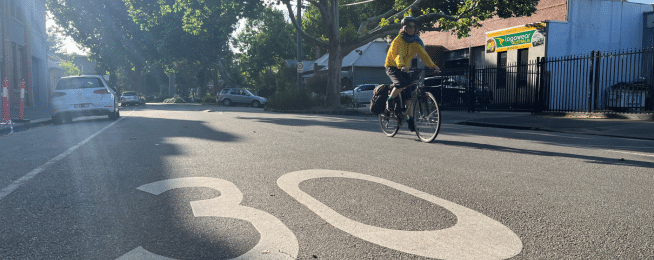It's happened in Brussels and it's happened in Paris. It's happened right across Wales and it's about to happen in Amsterdam.
Now 30km/h default speed limits are coming to the Melbourne suburbs of Fitzroy and Collingwood.
The City of Yarra has joined forward-thinking governments around the world in envisioning vibrant neighbourhoods with less pollution, less congestion and more people out enjoying public spaces.
The council was unanimous in its vote this month to expand a 30km/h speed limit trial to cover all local streets within Fitzroy and Collingwood. The move has been celebrated by road safety advocates and sustainable transport experts.
Pending state government approval and external funding, the changes could be implemented as early as February.
A 30km/h speed limit trial began in the Yarra council area in 2018, applying to the blocks bound by the arterial roads of Alexandra Parade, Hoddle Street, Nicholson Street and Johnston Street.
The council now plans to expand the go-slow zone south of Johnston Street to Victoria Parade, and bring the benefits of low-speed streets to a new section of the community (seen in blue below).

Council surveys reveal 68% of locals in the existing trial area support 30km/h speed limits, as do 59% of the locals in the proposed trial expansion area.
Brunswick Street, Gertrude Street and Smith Street all have trams and may require modifications before becoming part of the trial, but the council report recommends they be included at the earliest possible opportunity.
The OECD recommends 30km/h as the gold standard for speeds on streets where vulnerable road users mix regularly with traffic. As they've been implemented in cities around the world, the supporting evidence has grown more compelling.
London introduced 20mph (32km/h) speed limits in the central Congestion Charging Zone in 2020 and overall collisions have fallen by 25%, while collisions with vulnerable road users have decreased by 36%.
The City of Edinburgh introduced 30km/h speed limits on 80% of its streets in 2016, reducing collisions by 40%, fatalities by 39% and serious injuries by 33% within a year.
From next month, Amsterdam will drop speed limits to 30km/h on 80% of its streets and expects it to result in 20-30% fewer collisions.
Beyond addressing road trauma directly, lower speed limits also have a key role to play in uptake of active travel.
It is well established that low speeds and traffic calming measures make streets more welcoming places to ride bikes. These are key features of two existing, popular commuter routes through the City of Yarra, in Canning Street and Napier Streets.
The Climate Council has urged Australians to triple bike riding and walking to help the nation meet its emissions reductions targets.
So, could we see more low-speed streets around Australia? They have been trialled in other locations including Perth, Newcastle and Wollongong.
In August, NSW made significant changes to its speed zoning standards, include guidelines for 30km/h streets for the first time.
In Victoria, 30km/h speed limit trials can only be applied in "exceptional circumstances" and will be assessed on a case-by-case basis by the Department of Transport.
Bicycle Network has campaigned for low speed local streets for many years. Read more about what we're doing here.
Or become our friend and subscribe to receive our fortnightly newsletter.


